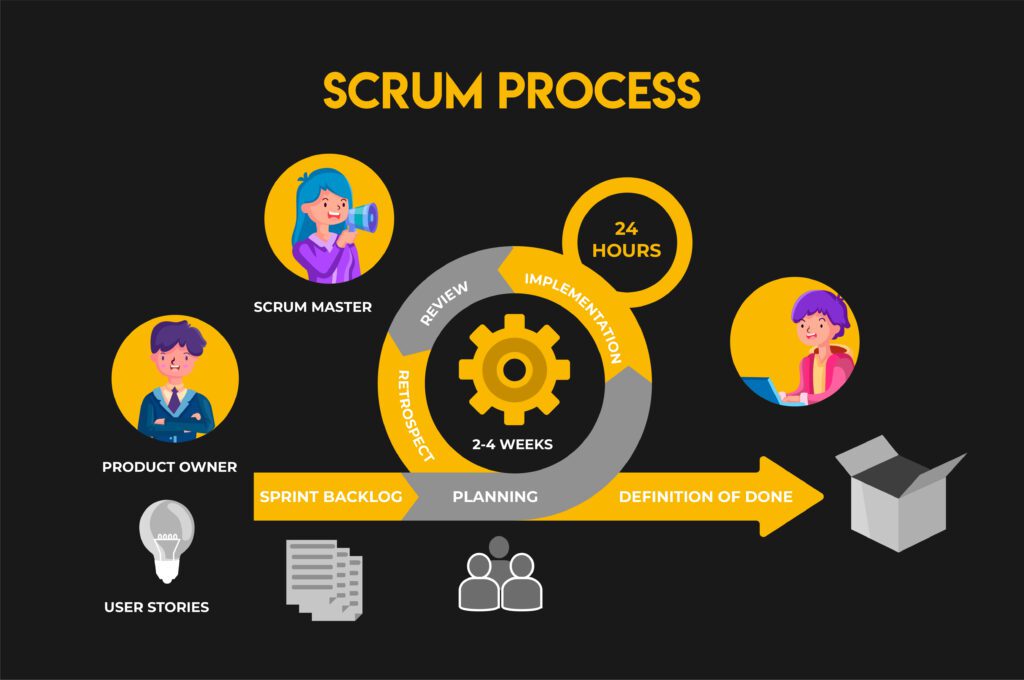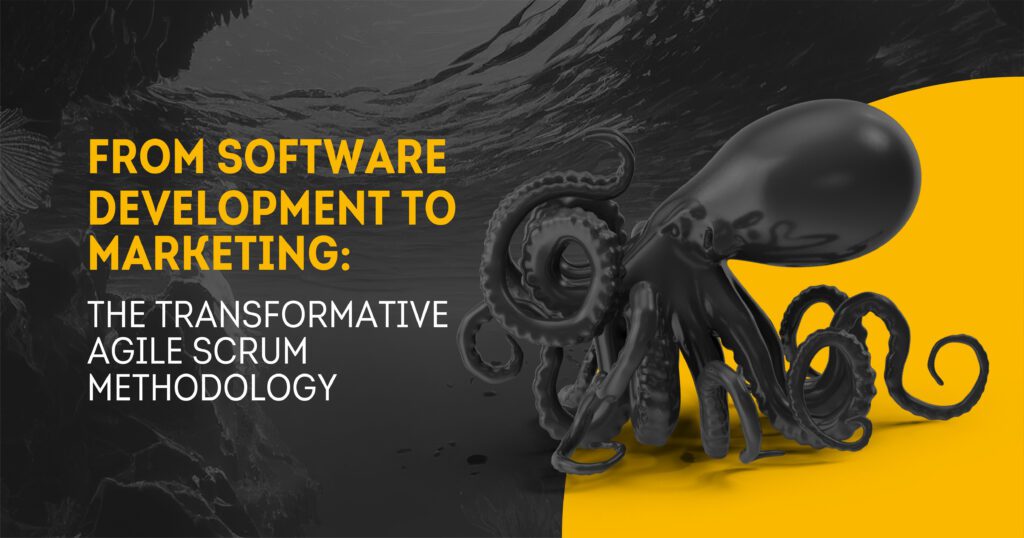Agile scrum method has become a go-to framework for efficiency and adaptability. It’s an efficient method that helps people collaborate better. Initially designed for computer software, it’s now used in various fields. These fields include marketing, where it is simplifying projects and tasks. Businesses always try to stay ahead in the fast-paced world of customer demands. For such companies, this method has become a guiding light. This blog will explore the agile scrum method and how it transforms marketing. We will explore how it makes work better, teamwork stronger, and success bigger in the future!
What is Agile Scrum?
While agile and Scrum are different, they can be used together as one methodology. Agile Scrum combines agile philosophy and the scrum framework. It focuses on iterative development, continuous improvement, and customer involvement. Key components include:
- Scrum Team: A team that consists of various roles. These roles include a Scrum Master, Product Owner, and development team members.
- Scrum Master: Ensures that team members understand the framework. They help the team remove obstacles that slow progress and ease Scrum events.
- Product Owner: The product owner is the stakeholder and defines the project’s priorities. They are responsible for the product backlog.
- Sprint: A time-boxed cycle, typically from 2 to 4 weeks. During a sprint, the development team works to complete a set of user stories or tasks.
- Backlog: A prioritized list of all the required work for the project. It includes features, user stories, and tasks.
- User Stories: User stories are brief, concise descriptions of a feature or functionality. They help understand project needs from an end-user point of view.
- Sprint Planning: The team holds a sprint planning meeting at the beginning of each sprint. They then select a set of user stories from the backlog to work on.
- Daily standup\scrum: A short meeting where team members discuss their progress and challenges and plan their daily work.
- Sprint Review: At the end of each sprint, the team sends the completed work for review and feedback.
- Sprint Retrospective: After each sprint, the team reflects on what went well and what they can improve. The aim is to make continuous process improvements.
- Empirical Process Control: Agile Scrum builds on transparency, inspection, and adaptation. It allows teams to adjust projects at different stages based on real-time feedback.

The Process of Agile Scrum
The Agile Scrum process is similar to a race with short laps called ‘sprints.’ In each lap, the team works on tasks from a to-do list called the ‘product backlog.’ They have quick daily meetings to discuss their work and fix any issues. After each lap, they review what went right, what didn’t, and how they can do better next time.
Scrum Teams: How Do They Work Together?
Scrum is all about teamwork and getting things done. To make this happen, teams have three set roles:
- The Product Owner: They decide what needs to be done. Think of them as the project boss.
- The Scrum Master: The manage the day-to-day processes. They ensure nothing stops progress, run daily meetings, and help the team. Sometimes, the Scrum Master is the same as the Project Owner.
- Team Members: Each team member handles their tasks. There’s no boss breathing down their necks. They talk to each other a lot, so everyone is in the picture.


Outgrowing Software Development: Agile Scrum in the World of Marketing
As we mentioned above, this framework was created by developers for IT, but it is now used in different fields. Marketing departments can be a bit chaotic. It’s like when your school projects are all over the place – disorganized, missed deadlines, and lots of stress. Agile Scrum has become essential in dealing with the fast-paced marketing world. It has changed how marketing teams do their projects. Marketing teams are creative and inventive. They see the value of this method in bringing structure and efficiency to their work. Agile Scrum focuses on development, customer feedback, and team communication. This is why it fits in perfectly with the smooth flow of marketing campaigns. It helps marketers respond quickly to changing markets, make the most of opportunities, and keep their focus on the customer. It recognizes that marketing is no longer a one-size-fits-all procedure. Instead, it views it as a dynamic and developing experience.
The Agile Scrum Manifesto: Values and Principles
The Agile Manifesto was created by a group of developers to improve how they write code. It outlines some key principles and values.
Principles of Agile Scrum:
- Put customer satisfaction first.
- Be open to change and adapt quickly.
- Deliver working software regularly, preferably in shorter times.
- Work closely with customers and stakeholders.
- Build projects around motivated individuals and support them.
- Prefer face-to-face communication when possible.
- Measure progress mainly by seeing working software.
- Keep a sustainable development pace.
Values of Agile Scrum:
- Value individuals and interactions over processes and tools.
- Prioritize working software over lots of documentation.
- Emphasize customer collaboration over strict contracts.
- Be ready to respond to change instead of sticking rigidly to a plan.
Agile Scrum Methodology in Marketing
Agile Scrum isn’t just for Software Development – marketing teams use it too. Many marketing teams are adopting this method to improve their project management practices. One example of such a team is Joint Media House, which is one of the first adopters of this framework in the Middle East. Here’s how it helps:
- Adapting to Changes: Agile Scrum lets teams adjust strategies quickly to match the market.
- Happy Customers: Involving customers and gathering feedback makes for better campaigns and keeps customers happy.
- Teamwork: Daily meetings and regular talks help teams work better together and spot issues early.
- Less Risk: Agile Scrum finds problems early, reducing campaign failures and costly errors.
- Faster Marketing: Smaller campaign parts mean quicker launches, so teams can grab opportunities and grow faster.
Benefits of Agile Scrum Marketing
Agile isn’t just another hype. It’s about achieving real results and making work better. Here’s why it works:
Increased Efficiency: Agile makes us work faster and smarter. We can tackle more projects and serve more customers by focusing on priorities.
Boosted Innovation: Agile encourages quick testing and data-driven decisions. This means our marketing can be on the spot, driven by insights, not guesses. We can also come up with new ideas and put them to work.
More ROI, Less Cost: Agile lets us run multiple campaigns without sacrificing effectiveness. Modern analytics help us measure ROI more accurately, potentially saving costs while boosting results.
Built for Growth: As we expand, Agile keeps us efficient. It’s like a growth-friendly toolkit for marketing success.
Customer-Centric: Agile keeps our eyes on the prize – delivering what our customers want.
So, why go Agile? It’s the real deal, making our marketing more efficient, innovative, and customer-focused.


Why Daily Standups Matter for Marketers
Daily standup meetings are like team huddles. They help us stay connected and work together smoothly. Here’s why they’re important:
Keeping everyone on the same page: When we work together, we need to talk and share what we’re doing.
Talking at the start of the day: We set time aside in the morning to talk about our plans.
Stopping problems early: If something’s going wrong, we talk about it before it gets too bad.
And the best part? These meetings are short and fun, so they don’t get in the way of our work.”
The Scrum Master’s Role in the Meeting
In daily scrum meetings, someone has to take charge to make sure everything goes smoothly. This person is like the team captain and ensures:
The meeting starts on time and everyone attends
Keep the meeting focused and organized so everyone gets a chance to talk.
Checking that the team is working on the right things. If not, they help them get back on track.
Making sure the team has what they need to do their work. If someone’s stuck, they help them out.
It’s like having a coach on the team to help us win the game!”
How to Make Marketing Better with Agile Sprint Retrospectives
After finishing a project or a sprint, it is good to have a sprint retrospective. These meetings can last from 30 minutes to an hour. They are like a report card for the team. We look at what went right, what could have gone better, and how we can do even better next time.
Running retrospectives isn’t hard, but it has to be done well and regularly.
What’s a Sprint Retrospective? A retrospective is like a team meeting where we:
- Celebrate successes.
- Admit where we messed up.
- Figure out how to do better.
It’s a chance for the whole team to look back and learn, whether it’s after a sprint or even at the end of a week, to review everything we’ve done.”
Why Isn’t Everyone Adopting the Agile Framework?
You know, doing things in an agile way sounds fantastic, but it is not for everyone. Here are some reasons why some people avoid it:
- People Like What’s Comfortable: If things have been going okay for a while, people don’t want to change things up. Sticking to your comfort zone feels safe and easy.
- Fear of Failure: Trying new things can be a bit scary. People worry they might mess up, so they stick with what they know, even if it’s not the best.
- Some Just See Things Differently: Not everyone agrees with the concept of agile methodology. Some individuals may have their own perspectives on how tasks should be approached.
- Change is Hard: Changing how a whole team or company works takes effort. It’s like learning a new game – not everyone is up for the challenge.
- Worrying About Blame: People often blame themselves or others when things go wrong. This fear of being blamed can make them hesitant to try new stuff.
But here’s the thing: although not everyone is doing it, agile can help us work better and get better results. We just need to find ways to overcome these challenges and show how agile can make a real difference!”
What Do You Need for Successful Agile Marketing?
Before making big changes to your company, there are some important things to consider for a smooth shift:
- Openness to Change: Change can be scary, so being open to new things is key. It’s okay not to have all the answers on the go. In the long run, your work will improve.
- Support from Everyone: If your team and decision makers aren’t on board with the changes, it’s hard to make agile work.
- Understanding Agile: To make it work, you need a deep understanding of it. Sometimes, companies only do bits of it without really understanding the whole picture.
So, to make agile work, you need an open mindset, support from your team, the right tools, and a deep understanding of why agile is awesome.”
Marketing Challenges and Agile Solutions
Implementing Agile Scrum in marketing comes with challenges and solutions.
Challenges:
Change Resistance: Teams may resist new methods.
User Story Hurdles: Crafting clear objectives can be tricky.
Solutions:
Team Training: Educate teams about Agile Scrum.
Support and Motivation: Encourage teams to embrace change.
Divide Tasks: Split complex jobs into smaller parts.
Agile Scrum vs. Waterfall Framework
Agile Scrum Vs. Waterfall Framework
The Agile Scrum framework and the Waterfall framework are distinct methods of project management. The Waterfall framework is a linear and sequential process. It consists of an organized series of stages:
- Requirements
- Design
- Implementation
- Testing
- Deployment
- Maintenance.
Each stage must be completed before moving on to the next. This leaves teams less adaptive to changes that may occur during the course of a project’s existence. One of the primary shortcomings of the Waterfall framework is it assumes that all requirements can be defined upfront. This is not suitable for projects where requirements evolve or are unclear initially. In some projects, expectations change after the project has commenced. In this case, rigidity can lead to :
- Delayed timelines
- Increased costs
- Dissatisfaction among stakeholders
This highlights the limitations of the Waterfall approach in dynamic and project.
A Final Note on Agile Scrum
Agile Scrum has emerged as a transformational force in project management. It moved beyond its roots in software development to reach areas such as marketing. This dynamic approach has several strengths, such as :
- Flexibility
- Customer collaboration
- Iterative progress
It provides a roadmap to navigate the complexities of the fast-paced digital age. Agile Scrum empowers teams to thrive in dynamic environments where frameworks like Waterfall fall short. With its help, teams can :
- Improves teamwork
- Promotes customer-centricity,
- Reduces risks
- Improve project outputs
- Increase customer satisfaction.
This framework is the framework of the future. It helps businesses stay ahead in a world defined by changing client needs. Its ideas, values, and practices provide a clear route to:
- Improved productivity
- More efficient collaboration
- Higher performance in an ever-changing environment.


